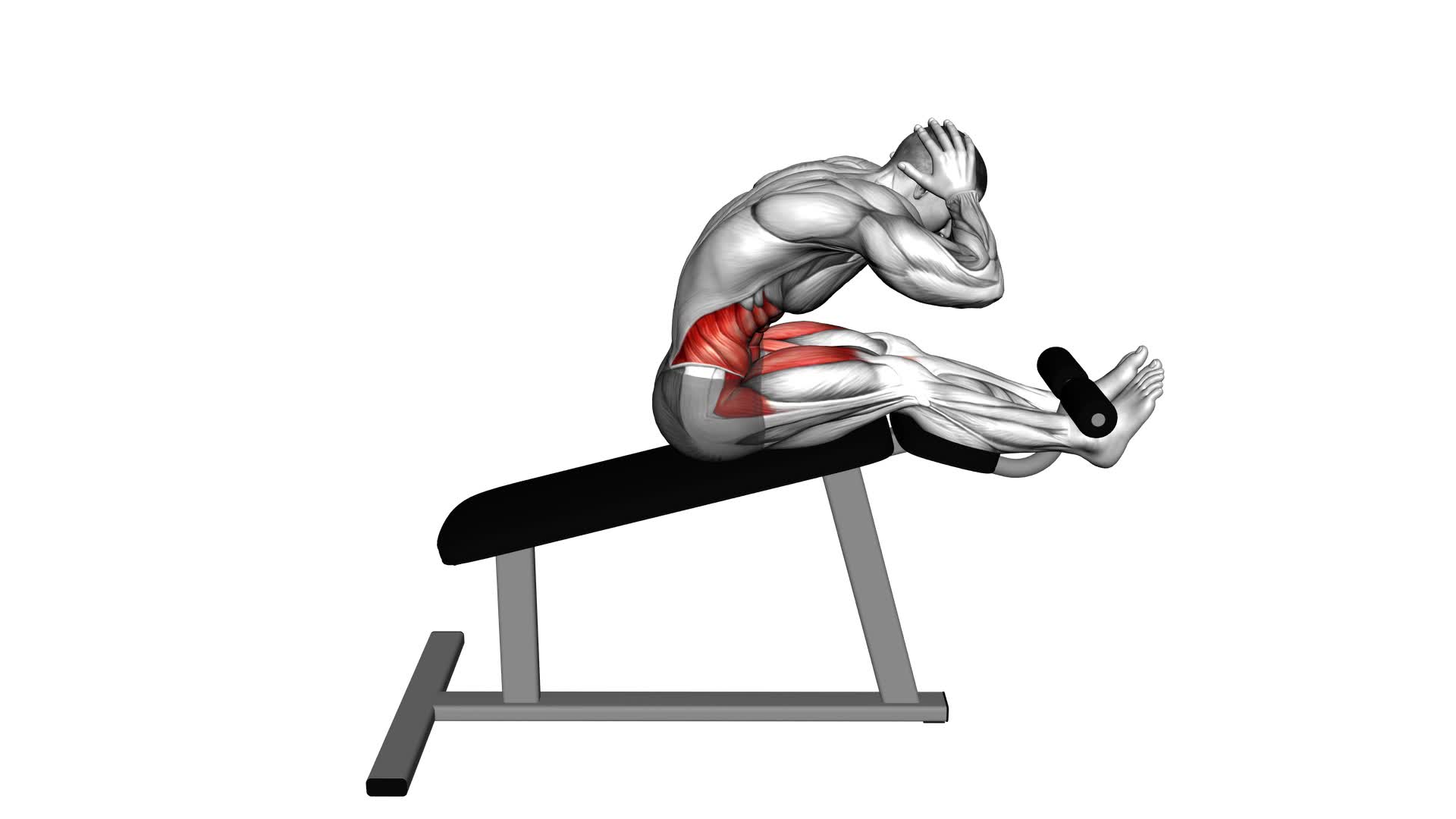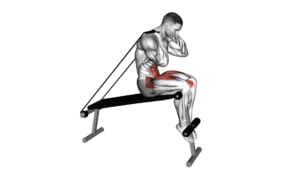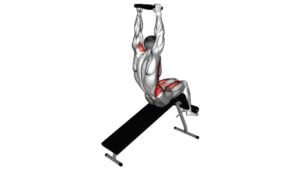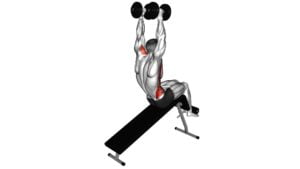Decline Sit-up (VERSION 3) – Video Exercise Guide & Tips

Are you looking for a challenging core exercise? Look no further than the Decline Sit-up (Version 3).
Watch This Exercise Video
In this video exercise guide, we'll show you the proper form and technique to perform this move effectively.
Whether you're a beginner or an advanced fitness enthusiast, we've got modifications and variations to suit your fitness level.
Avoid common mistakes and maximize the effectiveness of your workout with our helpful tips.
Let's get started on sculpting those abs!
Key Takeaways
- Increased core strength
- Enhanced abdominal muscle definition
- More effective targeting of lower abdominal muscles
- Importance of proper form and technique
Benefits of the Decline Sit-up (VERSION 3)
You will experience increased core strength and enhanced abdominal muscle definition when performing the Decline Sit-up (VERSION 3). This exercise is highly beneficial for maximizing the effectiveness of your abdominal workout. By incorporating the decline angle, you're increasing the resistance placed on your abdominal muscles, leading to greater muscle activation and growth.
One of the key benefits of the Decline Sit-up (VERSION 3) is its ability to target the lower abdominal muscles more effectively than traditional sit-ups. The decline angle forces your lower abs to work harder as they're responsible for lifting your upper body against gravity. This not only strengthens your lower abs but also helps to flatten and tone your stomach.
Additionally, the Decline Sit-up (VERSION 3) engages your hip flexors, which are the muscles responsible for flexing your hips. By involving these muscles, you aren't only targeting your abs but also improving your overall core strength and stability.
Furthermore, this exercise helps to improve your posture by strengthening your core muscles, which play a vital role in maintaining proper alignment of your spine. As a result, you may experience reduced back pain and improved balance.
Equipment Needed for the Exercise
To perform the Decline Sit-up (VERSION 3), you'll need a decline bench or an adjustable gym equipment that allows for decline positioning. This equipment is crucial for targeting and engaging your abdominal muscles effectively. The decline bench is specifically designed to provide a decline angle, which increases the level of difficulty and intensity of the exercise.
If you don't have access to a decline bench, there are some modifications and variations you can try. One option is to use an adjustable weight bench and set it to a decline position. Alternatively, you can use a stability ball placed on an incline board or against a wall. This will create a similar decline angle and provide the necessary support for your lower back.
When it comes to modifications and variations, you can make the exercise easier or more challenging depending on your fitness level. For beginners or those with lower core strength, you can start by performing the sit-up on a flat surface before progressing to a decline position. On the other hand, if you want to increase the difficulty, you can hold a weight plate or dumbbell against your chest while performing the sit-up.
Remember to always use proper form and technique when performing the Decline Sit-up (VERSION 3) and listen to your body to avoid any injuries.
Proper Form and Technique for the Decline Sit-Up (Version 3)
To perform the decline sit-up with proper form and technique, it's important to focus on maintaining spine alignment throughout the exercise. Keep your back straight and avoid arching or rounding your spine.
Additionally, pay attention to your breathing, exhaling as you lift your torso and inhaling as you lower it back down.
Lastly, be mindful of common mistakes such as pulling on your neck or using momentum to complete the movement, as these can compromise the effectiveness of the exercise.
Spine Alignment During Sit-Ups
Maintain proper spine alignment throughout the decline sit-up by engaging your core and keeping your back straight. This is crucial for both spine health and core strength.
When performing the decline sit-up, make sure to keep your spine in a neutral position, avoiding excessive arching or rounding of the back. Engage your abdominal muscles to support your spine and prevent any strain or injury.
By maintaining proper alignment, you can effectively target your abdominal muscles and minimize the risk of back pain. As you contract your abs and lift your torso, focus on keeping your spine straight and aligned with your head and neck. This will help you achieve optimal results and promote a healthy spine.
Now let's move on to the next section and explore breathing techniques for sit-ups.
Breathing Techniques for Sit-Ups
Engage your core and maintain proper spine alignment while performing the decline sit-up, focusing on your breathing technique. Proper breathing techniques during sit-ups are essential for maximizing performance and preventing injury.
Here are three key tips to help you master your breathing during decline sit-ups:
- Inhale before you begin the upward movement of the sit-up. This helps expand your diaphragm and allows for better oxygen intake.
- Exhale as you perform the upward movement, contracting your abdominal muscles to initiate the sit-up. This helps to engage your core and provide stability.
- Inhale again as you lower your body back down to the starting position, allowing your muscles to relax and recover.
Common Mistakes to Avoid
Avoid these common mistakes to ensure proper form and technique for the decline sit-up (Version 3).
One of the most important things to remember is to avoid excessive spinal flexion, which can put unnecessary strain on your lower back. Instead, focus on engaging your core muscles to perform the movement.
Another common mistake to avoid is hip flexor dominance. Many people tend to rely on their hip flexors to initiate the sit-up, rather than using their abdominal muscles. This can lead to imbalances and potential injuries.
To prevent this, make a conscious effort to activate your abs and maintain control throughout the entire range of motion.
Modifications and Variations to Suit Different Fitness Levels
To modify and vary the Decline Sit-up (VERSION 3) exercise to suit your fitness level, try incorporating different equipment or adjusting the angle of the decline bench. Here are some modifications and variations you can consider:
- Use a resistance band: Attach a resistance band around the decline bench and hold the ends while performing the sit-up. This will add resistance and increase the intensity of the exercise.
- Use a medicine ball: Hold a medicine ball against your chest while doing the sit-up. This will engage your core muscles even more and make the exercise more challenging.
- Adjust the decline bench angle: If you find the exercise too difficult, you can start by adjusting the decline bench to a lower angle. As you get stronger, gradually increase the angle to make the exercise more challenging.
By incorporating these modifications and variations, you can tailor the Decline Sit-up (VERSION 3) to your fitness level and continue to progress over time.
Now, let's move on to the next section and discuss common mistakes to avoid while performing the exercise.
Common Mistakes to Avoid While Performing the Exercise
When performing the Decline Sit-up (VERSION 3), be mindful of these common mistakes to ensure proper form and maximize the effectiveness of the exercise.
First and foremost, prioritize spine protection by avoiding jerky movements or excessively arching your back. It's important to maintain a neutral spine throughout the exercise to prevent injury and strain on your lower back.
Another mistake to avoid is relying solely on momentum to complete the movement. Instead, focus on engaging your core muscles to initiate and control the movement. This won't only improve the effectiveness of the exercise but also prevent strain on your neck and shoulders.
Additionally, be cautious not to pull on your neck or use your hands to lift your upper body. These actions can place unnecessary strain on your neck and may lead to discomfort or injury. Instead, keep your hands lightly placed on your temples or crossed over your chest to support your head without assisting in the movement.
Tips for Maximizing the Effectiveness of the Decline Sit-Up (Version 3)
To maximize the effectiveness of the Decline Sit-Up (Version 3), focus on maintaining proper form throughout the exercise.
Engage your core by exhaling forcefully as you contract your abdominal muscles and lift your upper body.
Additionally, gradually increase the intensity of the exercise by adding resistance or performing more repetitions over time.
Proper Form Techniques
Maximize the effectiveness of your decline sit-up (Version 3) by focusing on proper form techniques.
Paying attention to spine alignment is crucial to avoid straining your back during the exercise. Maintain a neutral spine by keeping your head, neck, and back in a straight line.
Engaging your core and keeping it tight throughout the movement will provide stability and protect your spine.
Additionally, breathing techniques play a significant role in optimizing your performance. Exhale as you contract your abdominal muscles and lift your torso, and inhale as you lower back down.
This controlled breathing pattern helps you maintain control and stability during the exercise.
By mastering proper form techniques such as spine alignment and breathing, you can enhance the effectiveness of your decline sit-up (Version 3) and minimize the risk of injury.
Now, let's move on to the next section about breathing and core engagement.
Breathing and Core Engagement
Focus on your breathing and engage your core to maximize the effectiveness of the decline sit-up (Version 3). Proper breathing techniques play a crucial role in enhancing your performance during this exercise.
As you lower your upper body towards the decline bench, exhale and engage your core muscles by pulling your belly button towards your spine. This not only helps to stabilize your body but also activates your deep abdominal muscles, making the sit-up more challenging and effective.
When you reach the top of the movement, inhale deeply and allow your chest to expand. By focusing on your breath and engaging your core, you'll strengthen your abdominal muscles more efficiently.
Now that you understand the importance of breathing and core activation, let's move on to discussing gradual intensity progression in the next section.
Gradual Intensity Progression
As you progress in your decline sit-up (Version 3) routine, it's important to gradually increase the intensity to further challenge your abdominal muscles. By incorporating a gradual progression into your workout, you can maximize the effectiveness of the exercise and continue to build core strength.
Here are three tips for gradually increasing the intensity of your decline sit-up (Version 3) routine:
- Increase the number of repetitions: Start by performing a comfortable number of sit-ups and gradually increase the repetitions over time. This will help to build endurance and strengthen your abdominal muscles.
- Add resistance: Once you have mastered the basic decline sit-up (Version 3), you can add resistance by holding a weight plate or dumbbell against your chest. This will provide an additional challenge for your core.
- Increase the angle of decline: As you become stronger, you can increase the angle of decline on the sit-up bench. This will increase the difficulty of the exercise and further engage your abdominal muscles.
Remember to listen to your body and progress at a pace that feels challenging but manageable. Gradually increasing the intensity of your decline sit-up (Version 3) routine will help you build core strength and achieve your fitness goals.
Frequently Asked Questions
How Many Calories Can You Burn by Doing Decline Sit-Ups (Version 3)?
You can burn a significant amount of calories by incorporating decline sit-ups (version 3) into your daily workout routine. This exercise targets your abdominal muscles and helps strengthen your core.
To maximize calorie burn, make sure to perform the decline sit-ups correctly. Lie on a decline bench, hook your feet securely, and place your hands behind your head. Engage your core as you lift your upper body towards your knees.
Remember to breathe and maintain proper form throughout the exercise.
Can Decline Sit-Ups (Version 3) Help in Achieving Six-Pack Abs?
Decline sit-ups (version 3) can definitely help you achieve six-pack abs! To get the best results, focus on maintaining proper form and technique. Keep your back straight, engage your core, and use controlled movements.
As for variations and modifications, there are options for different fitness levels. Beginners can start with a smaller decline angle or use assistance, while advanced individuals can add weights or incorporate twists.
Remember to listen to your body and progress at your own pace.
Are Decline Sit-Ups (Version 3) Suitable for People With Lower Back Pain?
If you're dealing with lower back pain, it's important to consider modifications for decline sit-ups (version 3) that can help alleviate the discomfort.
You might want to try placing a rolled-up towel or small cushion under your lower back for added support.
Additionally, there are alternative exercises you can do that won't put as much strain on your lower back.
Consult with a fitness professional to find exercises that are suitable for you.
Can Decline Sit-Ups (Version 3) Help in Improving Posture?
Decline sit-ups (version 3) can definitely help improve your posture and core strength. By targeting your abdominal muscles and strengthening them, these exercises can contribute to better posture.
They also engage your core, which plays a crucial role in maintaining proper alignment and stability.
Incorporating decline sit-ups (version 3) into your workout routine can be an effective way to work towards a stronger core and better posture.
How Often Should Decline Sit-Ups (Version 3) Be Performed to See Results?
To see results from decline sit-ups (version 3), it's important to incorporate them into your full body workout routine. Performing them regularly will help. Remember to focus on proper form and technique to maximize the benefits.
Conclusion
In conclusion, the decline sit-up (version 3) is an effective exercise for strengthening the core muscles. It requires minimal equipment and can be modified to suit different fitness levels.
By maintaining proper form and avoiding common mistakes, you can maximize the effectiveness of this exercise.
Incorporate the decline sit-up (version 3) into your fitness routine to achieve a stronger and more toned core.

Author
Years ago, the spark of my life’s passion ignited in my mind the moment I stepped into the local gym for the first time. The inaugural bead of perspiration, the initial endeavor, the very first surge of endorphins, and a sense of pride that washed over me post-workout marked the beginning of my deep-seated interest in strength sports, fitness, and sports nutrition. This very curiosity blossomed rapidly into a profound fascination, propelling me to earn a Master’s degree in Physical Education from the Academy of Physical Education in Krakow, followed by a Sports Manager diploma from the Jagiellonian University. My journey of growth led me to gain more specialized qualifications, such as being a certified personal trainer with a focus on sports dietetics, a lifeguard, and an instructor for wellness and corrective gymnastics. Theoretical knowledge paired seamlessly with practical experience, reinforcing my belief that the transformation of individuals under my guidance was also a reflection of my personal growth. This belief holds true even today. Each day, I strive to push the boundaries and explore new realms. These realms gently elevate me to greater heights. The unique combination of passion for my field and the continuous quest for growth fuels my drive to break new ground.







